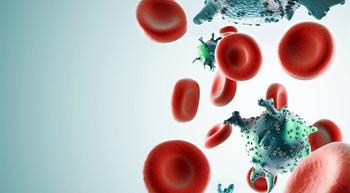
Survival With Immunotherapy in Common Brain Tumor Subtype May Be Predicted by a Biomarker
Patients with a common brain tumor subtype that expresses ERK1/2 activation may obtain a greater survival benefit with PD-1 immunotherapy, although research needs to confirm whether this can be observed in all patients.
Researchers may have discovered a biomarker to identify which patients with glioblastomas benefit from immunotherapy, although more research is needed in this area to determine whether it is a valid indicator of benefit.
Findings from the study published in Nature Cancer demonstrated that patients with recurrent glioblastoma and the presence of ERK1/2 activation may have improved survival after treatment with anti-PD-1 immunotherapy.
Glioblastoma is the most common brain tumor and can be the most malignant of all brain tumors, said senior/corresponding author Dr. Adam M. Sonabend, an associate professor of neurosurgery and director of translational neuro-oncology at Northwestern University Feinberg School of Medicine, in an interview with CURE®. He explained that initial management of these patients is clearly established — surgery, radiation, Temodar (temozolomide) and tumor-treating fields — and may prolong survival.
“Unfortunately, all patients ultimately recur,” Sonabend said. “When the patients recur with a brain tumor, very often, they’re actually doing very well clinically. But we know that this recurrence is ultimately fatal. As opposed to the initial diagnosis, when there’s a clear roadmap, this is no man’s land. Nothing out there has been shown to work.”
Sonabend spoke with CURE® about the reasoning behind using immunotherapy for
What was your team’s thought process behind the use of immunotherapy in patients with recurrent glioblastomas?
Immunotherapy is designed to remove the brakes of the immune system. The immune system has built-in brakes that will slow the activity of T cells and keeps the T cells from attacking your own body. One of these brakes is called PD-1. It’s a receptor on the lymphocytes on the T cells. And immunotherapy is a block of the PD-1. It's an antibody that will essentially stop the brake. … This led to long-term remissions of patients that otherwise were deemed to be incurable in a very-late stage of disease. … Some cancers like trans melanoma, renal cell carcinoma, lung cancer, these patients were suddenly responding and doing well.
I was operating on this patient with a colleague, and we said, “Why don't we start using immunotherapy? It’s having a nice response, cures and remissions in other cancers.” We were doing these informally without a clinical trial. We saw that most patients unfortunately didn't do well, but occasionally, a patient had a very strong immune response and some of them were very durable. These patients were surprisingly living much longer than what we expected. We started a very concerted effort to learn what's different about the tumors of these patients that respond versus those that don't.
What do the findings from this study add to the knowledge base?
We said, “Why don't we take all the patients, including some patients that got immunotherapy that live long, some patients that didn't live long, some patients that never got immunotherapy, and we stain with this antibody (that identifies ERK) to determine how much signaling cascade there is in the tumor cells?” To our surprise, we could tease apart and identify patients that will ultimately live long when given immunotherapy but not live long without immunotherapy. We could also tell which patients that didn't get immunotherapy regardless of how much of this ERK activation they had.
It's not perfect. There were some patients that have high elevation of ERK that didn't live long, but it was very statistically significant. The other thing that was interesting is we never found any patient with low levels of ERK that survive long with immunotherapy.
I had information on which patients had the mutations, who had
I was super excited and perplexed. We had to see if we can do this again in a different patient population. I reached out to colleagues at UCLA, and they had just finalized the clinical trial with a different group of patients treated with immunotherapy. I got the samples from their patients, and I did the same analysis. Once again, I was able to show that patients (who) have elevated ERK live longer.
This is all recurrent glioblastoma, but (UCLA) also gave me the samples of the tumors when they were originally diagnosed, meaning one or two years earlier for the same patient. I analyzed ERK in those samples, and it turns out it was a mess. … Looking at this biomarker at the wrong time point — too far ahead of when the patients got immunotherapy — was not informative and did not predict survival. What we learned with that dataset, in addition to validating what we have already observed, is that you needed to get a sample as close as possible to when you were going to start immunotherapy.
What further research is needed in this area?
Tumor cells in the brain don't grow in isolation packed against each other; they intermingle with brain cells. The most abundant component of this environment is called microglia, and these are the scavengers in the brain, the cells that help keep the brain clean and help fight infections in the brain. We started looking at the microglia of the patients who have elevated MAP kinase versus the patients that have low and it turns out that the microglia was very different. The microglia of the patients that have elevated ERK in the tumor cells were very nicely equipped to train lymphocytes and to show them what a tumor cell looks like. This is what we call antigen presentation.
One of the two important next steps is to understand what's the mechanism and how those tumor cells communicate with microglia cells when they have this activation to render the microglia cells more friendly to lymphocytes.
If I see a patient and he asked me, can we use (immunotherapy), I would have to be conservative. The best evidence always comes out of a clinical trial. Basically, what we have done is put forward an observation and association study. We published this generated hypothesis. Now formally, this needs to be looked at. And the hypothesis needs to either be validated or disregarded. For that, what you need to do is a human experiment, a clinical trial in which you look at the level of expression of ERK. This will determine will this ultimately make some people live longer given immunotherapy or not? That's a huge undertaking. That’s usually a clinical trial that might require 100 patients or more. That's what I consider the ultimate next step and what might actually lead this to change the lives of many patients.
If further research confirms your findings, how can this change clinical practice?
One of the reasons why we do surgeries for glioblastoma is for diagnosis. Initially, diagnosis is the ability to give the tumor a name and a last name. Over the last few years, diagnosis has gotten much more sophisticated. It’s not only what's the first name and the last name of the tumor, but what are the gene alterations and what can be actionable based on this information? Given the finding that we have, you would need to get a specimen from the tumor that was collected immediately before immunotherapy. The way this could be incorporated (into clinical practice) is that when the patients have surgery initially, we can measure this biomarker. If we get an answer that the biomarker predicts that this patient will likely benefit from immunotherapy, then we give this to the patient right away.
Now, say your tumor comes back and initially they did not get immunotherapy, I would advocate for a new biopsy because things could change over a year or two. And suddenly, we might have somebody who might benefit and live long. The way this would be incorporated is by measuring this in the tumor samples and telling a patient whether he's likely to benefit from these immunotherapies.
There's unfortunately a huge discrepancy between what we know and what we do (to treat patients). What we know is that tumors are very heterogeneous, particularly glioblastomas; some patients do well, some patients don't do well with a given treatment. What we do is we treat every patient the same way. Sometimes it works well, but most times, it doesn't.
The reason why we don't act according to what we know is because we don't have a way to identify these patients. This study offers the opportunity to help some patients and not waste energy, resources and threaten patients with toxicity and side effects of the therapies that might not help them for the rest of the patients. If (clinicians) can be smart about what drug (they) give to whom, (they’ll) help a lot of people.
This interview has been edited for clarity and conciseness.
For more news on cancer updates, research and education, don’t forget to




